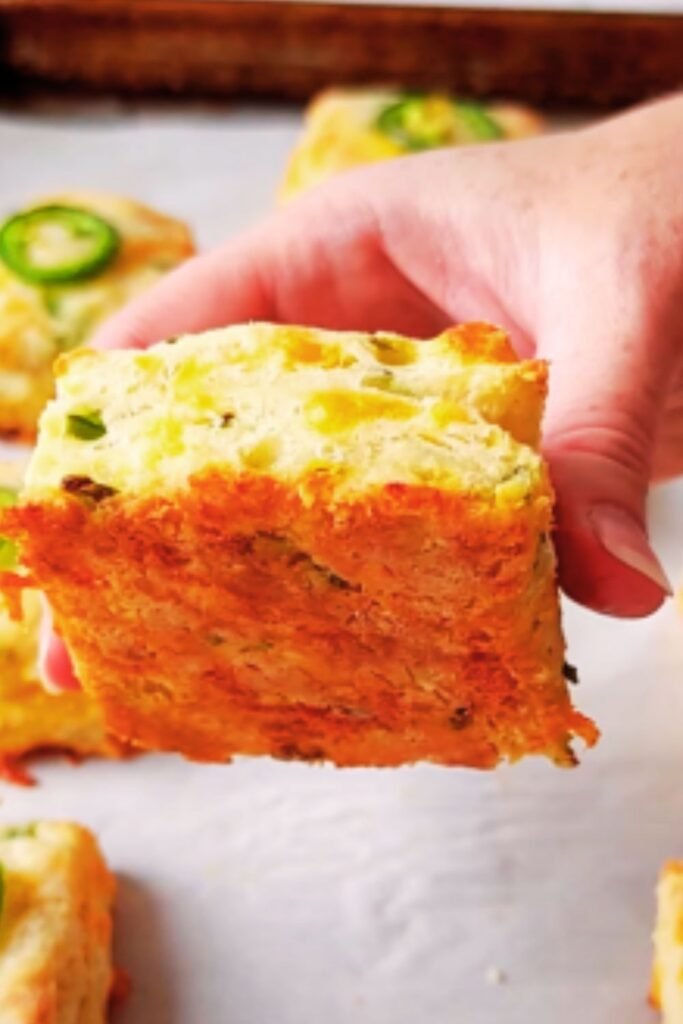There’s something magical about homemade biscuits that can transform an ordinary meal into something truly special. As someone who’s spent countless hours perfecting my biscuit technique, I’m thrilled to share my absolute favorite savory biscuit recipe with you today. These Black Pepper Cheddar Bacon Biscuits are the perfect combination of flaky, buttery, cheesy goodness with a peppery kick and smoky bacon flavor that will have everyone asking for seconds.
The Perfect Accompaniment
I first developed this recipe when I needed something spectacular to serve alongside a hearty potato soup on a cold winter evening. What started as a simple experiment has become my most requested recipe from friends and family gatherings. These biscuits strike the perfect balance between comfort food familiarity and gourmet flavor that makes them versatile enough for any occasion.
These biscuits aren’t just delicious—they’re also surprisingly straightforward to make. With some attention to detail and a few chef’s tricks I’ve picked up over the years, you’ll be creating bakery-quality biscuits in your own kitchen.
Why This Recipe Works
Before diving into the ingredients and steps, let me highlight what makes these biscuits special:
- The combination of butter and shortening creates the perfect texture—butter for flavor, shortening for flakiness
- Cold ingredients and minimal handling ensure tall, flaky layers
- Sharp cheddar provides rich cheese flavor without overwhelming moisture
- Bacon adds a smoky, savory element that complements the black pepper
- Buttermilk contributes tanginess and helps create tender biscuits
Ingredients Overview
Let’s take a closer look at what goes into these magnificent biscuits:
| Ingredient | Amount | Notes |
|---|---|---|
| All-purpose flour | 2½ cups (315g) | Unbleached preferred for better flavor |
| Baking powder | 1 tablespoon | Provides the primary lift |
| Baking soda | ¼ teaspoon | Activates with buttermilk for additional rise |
| Granulated sugar | 1 teaspoon | Enhances browning and balances savory flavors |
| Salt | 1 teaspoon | Diamond Crystal kosher salt preferred |
| Freshly ground black pepper | 1½ teaspoons | Coarse grind for better texture and flavor bursts |
| Unsalted butter | 6 tablespoons (85g) | Cold, cut into small cubes |
| Vegetable shortening | 2 tablespoons (28g) | Cold, cut into small pieces |
| Sharp cheddar cheese | 1½ cups (170g) | Freshly grated (pre-shredded has anti-caking agents) |
| Bacon | 8 slices (about 225g) | Cooked crisp and crumbled |
| Buttermilk | ¾ cup (180ml) | Cold, plus additional if needed |
| Heavy cream | 2 tablespoons | For brushing tops before baking |
Equipment Needed
While not complicated, having the right tools makes the biscuit-making process smoother:
- Large mixing bowl
- Pastry cutter or two knives (for cutting in fat)
- Measuring cups and spoons
- Box grater (for cheese)
- Baking sheet
- Parchment paper
- 2½-inch biscuit cutter (preferably metal with sharp edges)
- Pastry brush (for applying cream)
Step-by-Step Instructions
Preparation Phase
- Preheat your oven to 450°F (232°C) with a rack positioned in the middle.
- Line a baking sheet with parchment paper.
- Cook bacon until crisp, drain on paper towels, and crumble into small pieces.
- Grate the cheddar cheese and place it in the refrigerator until needed.
Making the Dough

- In a large bowl, whisk together the flour, baking powder, baking soda, sugar, salt, and black pepper.
- Add the cold butter and shortening pieces to the flour mixture.
- Using a pastry cutter or two knives, cut the fat into the flour until the mixture resembles coarse crumbs with some pea-sized pieces remaining. This creates pockets of fat that will melt during baking, creating flaky layers.
- Gently fold in the grated cheddar and crumbled bacon until evenly distributed.
- Create a well in the center of the mixture and pour in the cold buttermilk.
- Stir using a fork just until the dough begins to come together. The mixture should be slightly sticky but not wet. If too dry, add additional buttermilk 1 tablespoon at a time.
Shaping and Cutting

The key to tall, flaky biscuits lies in how you handle the dough at this stage:
- Turn the dough out onto a lightly floured surface.
- Gently pat the dough into a rectangle about 1-inch thick. Avoid using a rolling pin, which can compress the dough too much.
- Fold the dough in thirds, like a business letter. This creates additional layers.
- Turn the dough 90 degrees and gently pat it down again to about 3/4-inch thickness.
- Using a sharp-edged 2½-inch biscuit cutter, press straight down through the dough without twisting. Twisting seals the edges and prevents proper rising.
- Place cut biscuits on the prepared baking sheet, positioning them so they’re just touching each other. This helps them rise upward rather than spreading outward.
- Gather scraps, gently press together, and cut additional biscuits. Note that these may not rise quite as high as the first batch.
Baking
- Brush the tops of the biscuits with heavy cream for beautiful browning.
- Bake in the preheated oven for 12-15 minutes, until the tops are golden brown.
- Allow to cool on the baking sheet for 5 minutes before serving.
Expert Tips for Perfect Biscuits
As someone who’s made thousands of biscuits over the years, I’ve learned a few tricks that make a significant difference:
- Keep everything cold: I often chill my flour, bowl, and even the pastry cutter in the freezer for 15 minutes before starting. Cold ingredients mean flakier biscuits.
- Handle minimally: Overworking the dough develops gluten, resulting in tough biscuits.
- Use a sharp-edged cutter: Dull cutters or glasses can seal the edges of your biscuits and prevent proper rising.
- Proper placement: Placing biscuits close together helps them rise higher as they support each other during baking.
- Time matters: Work quickly to keep the butter from melting. If at any point the dough feels warm or the butter seems soft, refrigerate for 15-20 minutes before continuing.
Common Issues and Solutions
Even experienced bakers encounter problems occasionally. Here are solutions to common biscuit-making challenges:
| Issue | Possible Cause | Solution |
|---|---|---|
| Flat biscuits | Butter too warm | Chill ingredients thoroughly; work quickly |
| Twisting the cutter | Press straight down and up without rotating | |
| Oven not hot enough | Ensure oven is fully preheated to 450°F | |
| Tough biscuits | Overworked dough | Handle minimally; stop mixing when just combined |
| Too much flour | Use a light touch when flouring surfaces | |
| Dense texture | Old leavening agents | Check freshness of baking powder and soda |
| Not enough fat | Measure carefully; don’t reduce fat amounts | |
| Uneven browning | Uneven oven heat | Rotate pan halfway through baking |
| Irregular thickness | Pat dough to uniform thickness before cutting |
Flavor Variations
While I adore the classic black pepper, cheddar, and bacon combination, here are some delicious variations to try:
- Southwest Style: Add 1 tablespoon of chopped jalapeños and substitute pepper jack for the cheddar
- Herb Garden: Include 2 tablespoons of fresh chopped herbs like rosemary, thyme, and chives
- Garlic Lover’s: Add 2 teaspoons of roasted garlic paste to the dough
- Smokehouse: Use smoked gouda instead of cheddar and add 1/2 teaspoon of smoked paprika
Serving Suggestions

These biscuits shine in so many settings:
- Serve warm with a pat of butter for breakfast
- Split and fill with scrambled eggs for a breakfast sandwich
- Accompany soups, stews, or chili for a hearty dinner
- Offer as an alternative to dinner rolls at holiday meals
- Create mini versions for appetizers with country ham
- Use as the base for strawberry shortcake for a sweet-savory dessert
Storage and Reheating
To maintain freshness and flavor:
- Room Temperature: Store cooled biscuits in an airtight container for up to 2 days.
- Refrigerator: Extend freshness to 5-7 days by refrigerating in an airtight container.
- Freezer: Freeze fully cooled biscuits in a freezer bag for up to 3 months.
- Reheating: For that fresh-baked texture, wrap in foil and warm in a 350°F oven for 5-7 minutes. Alternatively, split and toast under the broiler.
Making Ahead
For freshly baked biscuits without the last-minute work:
- Prepare the dough and cut the biscuits.
- Place cut biscuits on a parchment-lined baking sheet and freeze until solid (about 2 hours).
- Transfer frozen unbaked biscuits to a freezer bag and store for up to 3 months.
- When ready to bake, place frozen biscuits on a baking sheet, brush with cream, and bake at 450°F for 15-18 minutes (adding 3-5 minutes to the regular baking time).
Nutritional Information
For those watching their intake, here’s an approximate breakdown per biscuit (based on a yield of 10 biscuits):
| Nutrient | Amount |
|---|---|
| Calories | 275 |
| Total Fat | 16g |
| Saturated Fat | 8g |
| Cholesterol | 40mg |
| Sodium | 480mg |
| Total Carbohydrates | 22g |
| Dietary Fiber | 1g |
| Sugars | 1g |
| Protein | 9g |
Q&A Section
Q: Can I substitute the buttermilk with something else? Yes! If you don’t have buttermilk, you can make a quick substitute by adding 2 teaspoons of lemon juice or white vinegar to regular milk and letting it sit for 5 minutes. You can also use thinned yogurt or sour cream in a pinch.
Q: Why do you use both butter and shortening? I use this combination because butter provides the incomparable flavor we all love, while vegetable shortening helps create those distinctive flaky layers. Shortening has a higher melting point than butter, which allows the biscuit structure to set before the fat melts completely.
Q: Can I make these biscuits without bacon for a vegetarian version? Absolutely! Simply omit the bacon and consider adding 1-2 tablespoons of finely chopped chives or green onions to maintain a depth of flavor. You might want to increase the black pepper slightly as well.
Q: My biscuits didn’t rise as high as I expected. What went wrong? Several factors affect biscuit height: freshness of leavening agents, temperature of ingredients, handling technique, and cutting method. Make sure your baking powder is fresh (replace every 6-12 months), your ingredients are cold, you’re handling the dough gently, and you’re cutting straight down without twisting.
Q: Can I use pre-shredded cheese to save time? While you can, I don’t recommend it. Pre-shredded cheese contains anti-caking agents that can affect both texture and melting properties. The few minutes it takes to grate your own cheese results in a significantly better biscuit.
Q: How can I ensure my biscuits are tender and not tough? The key is minimal handling. Mix just until the ingredients come together, and don’t overwork the dough when shaping and cutting. Using cold ingredients also helps, as does measuring your flour correctly (spoon into measuring cup and level off rather than scooping).
The Final Word
These Black Pepper Cheddar Bacon Biscuits represent everything I love about home baking—they’re comforting, impressive, and versatile. They’ve become my signature contribution to family gatherings and friendly potlucks, always disappearing within minutes.
Remember that biscuit-making is as much art as science. Don’t be discouraged if your first batch isn’t perfect. Each time you make them, you’ll develop a better feel for the dough and the confidence to adapt the recipe to your personal taste.
I hope these biscuits bring as much joy to your table as they have to mine. There’s something wonderfully satisfying about watching loved ones reach for seconds (or thirds) of something you’ve created from scratch. Happy baking!


